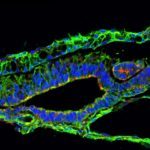Lien vers Pubmed [PMID] – 30554902
Curr. Biol. 2019 01;29(1):35-50.e4
Limb position along the body is highly consistent within one species but very variable among vertebrates. Despite major advances in our understanding of limb patterning in three dimensions, how limbs reproducibly form along the antero-posterior axis remains largely unknown. Hox genes have long been suspected to control limb position; however, supporting evidences are mostly correlative and their role in this process is unclear. Here, we show that limb position is determined early in development through the action of Hox genes. Dynamic lineage analysis revealed that, during gastrulation, the forelimb, interlimb, and hindlimb fields are progressively generated and concomitantly patterned by the collinear activation of Hox genes in a two-step process. First, the sequential activation of Hoxb genes controls the relative position of their own collinear domains of expression in the forming lateral plate mesoderm, as demonstrated by functional perturbations during gastrulation. Then, within these collinear domains, we show that Hoxb4 anteriorly and Hox9 genes posteriorly, respectively, activate and repress the expression of the forelimb initiation gene Tbx5 and instruct the definitive position of the forelimb. Furthermore, by comparing the dynamics of Hoxb genes activation during zebra finch, chicken, and ostrich gastrulation, we provide evidences that changes in the timing of collinear Hox gene activation might underlie natural variation in forelimb position between different birds. Altogether, our results that characterize the cellular and molecular mechanisms underlying the regulation and natural variation of forelimb positioning in avians show a direct and early role for Hox genes in this process.

